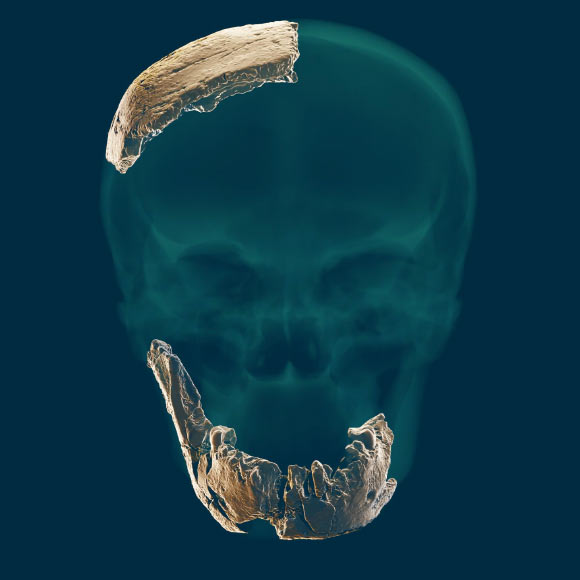The Nesher Ramla hominins lived between 420,000 and 120,000 years ago in the Middle East and had a distinctive combination of Neanderthal (especially the teeth and jaws) and archaic Homo (specifically the skull) features; they had fully mastered technology that until only recently was linked to either Homo sapiens or Neanderthals; they were efficient hunters of large and small game, used wood for fuel, cooked or roasted meat, and maintained fires.
“The discovery of a new type of Homo is of great scientific importance,” said Professor Israel Hershkovitz, a researcher in the Department of Anatomy and Anthropology and the Shmunis Family Anthropology Institute at Tel Aviv University.
“It enables us to make new sense of previously found human fossils, add another piece to the puzzle of human evolution, and understand the migrations of humans in the old world.”
“Even though they lived so long ago, in the Late Middle Pleistocene (474,000-130,000 years ago), the Nesher Ramla people can tell us a fascinating tale, revealing a great deal about their descendants’ evolution and way of life.”
Professor Hershkovitz and colleagues unearthed hominin bones and associated stone tools as well as animal (horse, fallow deer and aurochs) bones at the archaeological site of Nesher Ramla in Israel.
“This is an extraordinary discovery,” said Dr. Yossi Zaidner, a researcher in the Institute of Archaeology at the Hebrew University of Jerusalem and the Zinman Institute of Archaeology at the University of Haifa.
“We had never imagined that alongside Homo sapiens, archaic Homo roamed the area so late in human history.”
“The archaeological finds associated with human fossils show that the Nesher Ramla Homo possessed advanced stone-tool production technologies and most likely interacted with the local Homo sapiens.”
The discovery of the Nesher Ramla Homo challenges the prevailing hypothesis that Neanderthals originated in Europe.
“Before these new findings, most researchers believed Neanderthals to be a European story, in which small groups of Neanderthals were forced to migrate southwards to escape the spreading glaciers, with some arriving in the Land of Israel about 70,000 years ago,” Professor Hershkovitz said.
“The Nesher Ramla fossils make us question this theory, suggesting that the ancestors of European Neanderthals lived in the Levant as early as 400,000 years ago, repeatedly migrating westward to Europe and eastward to Asia.”
“In fact, our findings imply that the famous Neanderthals of Western Europe are only the remnants of a much larger population that lived here in the Levant — and not the other way around.”
“The oldest fossils that show Neanderthal features are found in Western Europe, so researchers generally believe Neanderthals originated there,” said Professor Rolf Quam, a researcher in the Department of Anthropology at Binghamton University, the Centro UCM-ISCIII de Evolución y Comportamiento Humanos, and the Division of Anthropology at the American Museum of Natural History.
“However, migrations of different species from the Middle East into Europe may have provided genetic contributions to the Neanderthal gene pool during the course of their evolution.”
The researchers were careful not to attribute the Nesher Ramla fossils to a new species of Homo.
Rather, they grouped them together with earlier fossils from several sites in the Middle East — such as from Tabun Cave (160,000 years old), Zuttiyeh Cave (250,000 years old), and Qesem Cave (400,000 years old) — that have been difficult to classify and considered all of them to represent a local population of humans that occupied the region between about 420,000 and 120,000 years ago.
“People think in paradigms. That’s why efforts have been made to ascribe these fossils to known human groups like Homo sapiens, Homo erectus, Homo heidelbergensis or Neanderthals,” said Dr. Rachel Sarig, a researcher in the Shmunis Family Anthropology Institute and the Department of Oral Biology at Tel Aviv University.
“But now we say: No. This is a group in itself, with distinct features and characteristics.”
“At a later stage, small groups of the Nesher Ramla Homo migrated to Europe, where they evolved into the classic Neanderthals that we are familiar with, and also to Asia, where they became archaic populations with Neanderthal-like features.”
“Europe was not the exclusive refugium of Neanderthals from where they occasionally diffused into West Asia,” added Professor Gerhard Weber, a researcher in the Department of Evolutionary Anthropology and the Core Facility for Micro-Computed Tomography at the University of Vienna.
“We think that there was much more lateral exchange in Eurasia, and that the Levant is geographically a crucial starting point, or at a least bridgehead, for this process.”
The research is described in a paper in the journal Science.
_____
Israel Hershkovitz et al. 2021. A Middle Pleistocene Homo from Nesher Ramla, Israel. Science 372 (6549): 1424-1428; doi: 10.1126/science.abh3169








